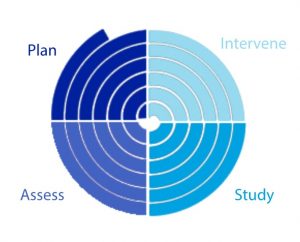
Our approach to Writing Across the Curriculum (WAC) is informed by transdisciplinary action research (TDAR), as described by Stokols (2006). The project is led by a transdisciplinary team of experts—faculty, academic professionals, and graduate students from science, engineering, writing studies, and technical communication—who work together to simultaneously develop and study interventions at multiple levels of collaboration. We have an iterative process, meaning that we cycle between conducting initial research, planning and guiding interventions, mentoring faculty and graduate students, and analyzing the effects of interventions. Along the way, members of our team grapple with the specific situated demands of writing in STEM, while drawing on and discussing writing pedgagogy research from writing studies, technical communication, and science education. Rather than a one-time intervention, we seek to build a long-term community that connects educators across the sciences and humanities. Further, by developing an iterative process, we can provide ongoing support to STEM faculty, academic professionals, and graduate students who are seeking to shift curricula, change course objectives, and revise assignments. We document and assess each intervention in order to inform the next in a constant cycle.
We also draw on a community-of-practice model, which informs our semester-long faculty learning community as well as our mentoring (Wenger, McDermott, & Synder, 2002; Cox, 2004). These learning communities seek to connect faculty and stakeholders across departments and colleges through the common project of teaching writing in STEM. Through workshops, conversations, and small group learning, as well as follow-up through mentoring and connection to a larger community of practice, we work together to create changes in writing instruction across STEM departments.

